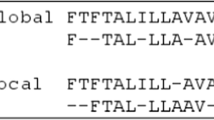Abstract
Accuracy on multiple sequence alignments (MSA) is of great significance for such important biological applications as evolution and phylogenetic analysis, homology and domain structure prediction. In such analyses, alignment accuracy is crucial. In this paper, we investigate a combined scoring function capable of obtaining a good approximation to the biological quality of the alignment. The algorithm uses the information obtained by the different quality scores in order to improve the accuracy. The results show that the combined score is able to evaluate alignments better than the isolated scores.





Similar content being viewed by others
References
Wang L, Jiang T (1994) On the complexity of multiple sequence alignment. J Comput Biol 4:337–348
Notredame C (2007) Recent evolutions of multiple sequence alignment algorithms. PLoS Comput Biol 3(8):e123
Feng DF, Doolittle RF (1987) Progressive sequence alignment as a prerequisite to correct phylogenetic trees. J Mol Evol 4:351–360
Notredame C, Higgins DG, Heringa J (2000) T-Coffee: a novel method for fast and accurate multiple sequence alignment. J Mol Biol 302:205–217
Thompson JD, Higgins DG, Gibson TJ (1994) CLUSTALW: improving the sensitivity of progressive multiple sequence alignment through sequence weighting, position-specific gap penalties and weight matrix choice. Nucleic Acids Res 22:4673–4680
Notredame C, Higgins DG (1996) SAGA: sequence alignment by genetic algorithm. Nucleic Acids Res 24(8):1515–1524
Goldberg DE (1989) Genetic algorithms in search, optimisation, and machine learning. Addison-Wesley, Reading
Edgar RC (2004) Muscle: multiple sequence alignment with high accuracy and high throughput. Nucleic Acids Res 32:1792–1797
Massachusetts Institute of Technology and Matthew Wall, GAlib. http://lancet.mit.edu/galib-2.4/
Lipman DJ, Altschul SF, Kececioglu JD (1989) A tool for multiple sequence alignment. Proc Natl Acad Sci USA 12(86):4412–4415
Thompson JD, Plewniak F, Ripp R, Thierry JC, Poch O (2001) Towards a reliable objective function for multiple sequence alignments. J Mol Biol 4(314):937–951
Kemena C, Taly JF, Kleinjung J, Notredame C (2011) STRIKE: evaluation of protein MSAs using a single 3D structure. Bioinformatics 24(27):3385–3391
Notredame C, Holm L, Higgins DG (1998) COFFEE: an objective function for multiple sequence alignments. Bioinformatics 5(14):407–422
Acknowledgements
This work was supported by the Ministry of Education and Science of Spain under contract TIN2011-28689-C02-02, TIN2010-12011-E and Consolider CSD2007-00050. MO is funded by the CUR of DIUE of GENCAT. CN is funded by the Plan Nacional BFU2008-00419 and the 7th Framework Programme of the European Commission through the LEISHDRUG project (no. 223414) and The Quantomics project (KBBE-2A-222664).
Author information
Authors and Affiliations
Corresponding author
Rights and permissions
About this article
Cite this article
Orobitg, M., Cores, F., Guirado, F. et al. Improving multiple sequence alignment biological accuracy through genetic algorithms. J Supercomput 65, 1076–1088 (2013). https://doi.org/10.1007/s11227-012-0856-9
Published:
Issue Date:
DOI: https://doi.org/10.1007/s11227-012-0856-9




